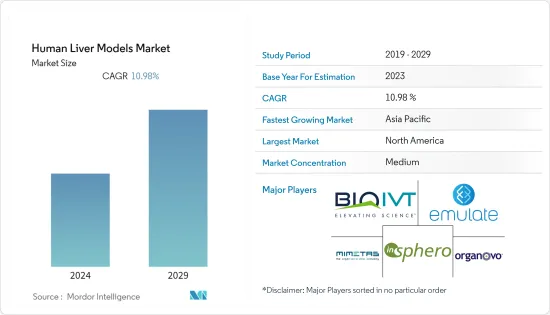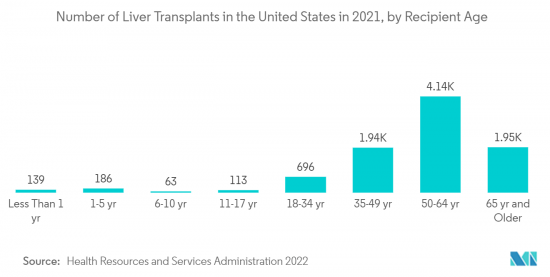PUBLISHER: Mordor Intelligence | PRODUCT CODE: 1405706

PUBLISHER: Mordor Intelligence | PRODUCT CODE: 1405706
Human Liver Models - Market Share Analysis, Industry Trends & Statistics, Growth Forecasts 2024 - 2029

The global human liver models market is valued at USD 0.3 billion and is expected to reach USD 0.46 billion by 2029, registering a CAGR of 10.98% over the forecast period.
The COVID-19 pandemic had a significant impact on the market studied. As per the data from the CDC published in October 2021, the geriatric population included patients with serious underlying medical conditions, including people with liver disease, who were at a higher risk for severe illness from COVID-19. Patients with hepatocellular carcinoma (HCC), which occurs most often in people with chronic liver diseases, such as hepatitis B or hepatitis C, were at a higher risk for severe COVID-19 than those without hepatocellular carcinoma. However, during the pandemic, the focus of the healthcare industry was inclined toward COVID-19 management, which affected the market studied. Currently, the market has reached its pre-pandemic nature in terms of research and demand for human liver models and is expected to witness strong growth in the coming years.
The key factors responsible for the market growth include the increasing prevalence of liver diseases and advancements in organ printing technologies. In addition, the increasing focus on developing alternatives for animal-based models and accuracy in outcomes is projected to boost market growth. Moreover, the increasing prevalence of non-fatty acid liver disease and alcohol consumption that is leading to liver diseases is anticipated to fuel the market growth over the forecast period.
The change in the current lifestyle led to the exposure of a large population to certain risk factors that contribute to liver cancer. The risk factors include type-2 diabetes, hepatitis, metabolic disorders, excess body weight, alcohol consumption, and smoking. According to the GLOBOCAN data, globally, in 2020, there were around 905,677 (4.7%) new liver cancer cases and 830,180 (8.3%) deaths due to liver cancer. Moreover, the high demand for therapeutic drugs for liver cancer is expected to create wide opportunities for the market players for drug discovery with the help of liver models.
Hepatocellular carcinoma (HCC) and chronic liver disease are fatal illnesses with few curative alternatives. Therapeutic research is hampered by a shortage of experimental models that are clinically applicable and tractable. As per the data from Precision Bioscience published in September 2021, there is a significant unmet medical need for chemoprevention of liver disease progression toward cancer development due to the high prevalence of advanced liver fibrosis and cirrhosis, which are predicted to impact between 1% and 2% of the world's population. Therefore, with the rising prevalence of liver diseases, there is a growing demand for human liver models for study purposes, which is augmenting the market growth.
However, the high cost of liver models and issues with the incorporation of liver models into the existing workflow are expected to hamper the market growth over the forecast period.
Human Liver Models Market Trends
Liver-on-a-Chip is Expected to Grow at Significant Rate
Liver-on-a-Chip is a bioengineered system that can simulate the key features of the fundamental function of the liver. Liver-on -a-chip are simpler and less expensive compared to other models. Furthermore, owing to the growing demand for low-cost alternatives for animal models for drug discovery and development, the segment is projected to grow at significant rates. The increase in initiatives for liver organoids and technological advancements in human organ modeling is anticipated to fuel the overall market growth.
Moreover, increasing liver infections and the use of liver models in the development of many drugs are expected to boost market growth over the forecast period. According to CDC data published in March 2021, each year in the United States, about 25,000 men and 11,000 women get liver cancer, and about 19,000 men and 9,000 women die from the disease. Also, the increase in consumption of alcohol around the world is leading to liver diseases, increasing the demand for liver models.
The quest for innovative in vitro methods for researching liver diseases can be facilitated by emerging technology and engineering techniques like microfluidics. Microfluidic organ-on-a-chip platforms are one of these methods that have grown significantly because they promise to speed up and cut expenses associated with medication development. For instance, the data from PubMed published in March 2022 indicated that liver-on-chip is one of the emerging technologies that is expected to gain wide adoption across the globe. In addition, the data from BioMed Central Journal published in December 2022 stated that to achieve crosstalk of a liver-on-a-chip with other organs, research studies are anticipated to develop the next generation of multi-organs-on-chips, such as a liver-kidney chip, liver-intestine chip, liver-immune chip, and finally a human-on-a-chip.
Hence, with the increasing importance of liver-on-chip technology, the segment is expected to witness strong growth in the coming years.

North America is Expected to Have Significant Market Share
North America is expected to have the majority of the market share owing to increasing R&D expenditure, innovation in organ models, and adoption of innovative potential therapies in the region. Moreover, the increasing prevalence of liver diseases and the presence of key market players in the region are anticipated to boost market growth over the forecast period.
The rising burden of liver cancer in the United States will likely propel market growth. For instance, per the data from the American Cancer Society published in November 2022, the estimated number of liver cancer cases in the United States was around 41,260 for 2022, a significant rise from the previous years. Hence, with the growing burden of liver cancer, the market studied is expected to grow strongly in the United States in the coming years.
Furthermore, a growing demand for liver transplants in the United States is augmenting the market growth. For instance, the Human Resource and Services Administration (HRSA) data published in June 2022 stated that 9,236 liver transplants occurred in the United States in 2021. Among the liver transplants, around 4,145 were done in people aged 50-64. With the increasing number of liver transplants, there is a growing demand for human liver models in the country, fueling market growth.
Human Liver Models Industry Overview
The global human liver models market is moderately consolidated and competitive. Market players are focusing on product innovations, new product launches, and regional expansions to increase their market share. The key market players operating in the market include Emulate, Inc., InSphero, BioIVT, Organovo Holdings Inc., and Mimetas, among others.
Additional Benefits:
- The market estimate (ME) sheet in Excel format
- 3 months of analyst support
TABLE OF CONTENTS
1 INTRODUCTION
- 1.1 Study Assumptions and Market Definition
- 1.2 Scope of the Study
2 RESEARCH METHODOLOGY
3 EXECUTIVE SUMMARY
4 MARKET DYNAMICS
- 4.1 Market Overview
- 4.2 Market Drivers
- 4.2.1 Increasing Prevalence of Chronic Diseases and Geriatric Population
- 4.2.2 Increasing Demand For Technologically Advanced Stretchers
- 4.3 Market Restraints
- 4.3.1 High Cost of Specialized Stretchers
- 4.3.2 Growing Adoption of Home Healthcare
- 4.4 Porter's Five Forces Analysis
- 4.4.1 Bargaining Power of Buyers/Consumers
- 4.4.2 Bargaining Power of Suppliers
- 4.4.3 Threat of New Entrants
- 4.4.4 Threat of Substitute Products
- 4.4.5 Intensity of Competitive Rivalry
5 MARKET SEGMENTATION
- 5.1 By Product Type
- 5.1.1 2D Models
- 5.1.2 3D Models
- 5.1.3 Liver-on-a-Chip
- 5.1.4 Other Product Types
- 5.2 By Application
- 5.2.1 Eduction
- 5.2.2 Drug Discovery
- 5.2.3 Other Applications
- 5.3 Geography
- 5.3.1 North America
- 5.3.1.1 United States
- 5.3.1.2 Canada
- 5.3.1.3 Mexico
- 5.3.2 Europe
- 5.3.2.1 Germany
- 5.3.2.2 United Kingdom
- 5.3.2.3 France
- 5.3.2.4 Italy
- 5.3.2.5 Spain
- 5.3.2.6 Rest of Europe
- 5.3.3 Asia-Pacific
- 5.3.3.1 China
- 5.3.3.2 Japan
- 5.3.3.3 India
- 5.3.3.4 Australia
- 5.3.3.5 South Korea
- 5.3.3.6 Rest of Asia-Pacific
- 5.3.4 Middle-East and Africa
- 5.3.4.1 GCC
- 5.3.4.2 South Africa
- 5.3.4.3 Rest of Middle-East and Africa
- 5.3.5 South America
- 5.3.5.1 Brazil
- 5.3.5.2 Argentina
- 5.3.5.3 Rest of South America
- 5.3.1 North America
6 COMPETITIVE LANDSCAPE
- 6.1 Company Profiles
- 6.1.1 Organovo Holdings Inc.
- 6.1.2 BioIVT
- 6.1.3 InSphero
- 6.1.4 Emulate, Inc.
- 6.1.5 Mimetas
- 6.1.6 CN Bio
- 6.1.7 Cyfuse Biomedical K.K.
- 6.1.8 HuREL Corporation
7 MARKET OPPORTUNITIES AND FUTURE TRENDS




